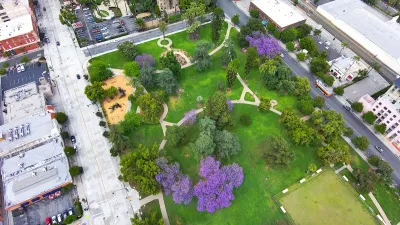Creating parks and open space in L.A. County requires overcoming land scarcity, high costs, and other challenges through strategic partnerships, innovative multi-benefit designs, and policy reforms to ensure equitable access and sustainability.

Greater Los Angeles faces significant challenges in providing adequate park space, ranking 88th among the top 100 U.S. cities in park access, acreage, and investment, according to the Trust for Public Land’s ParkScore Index. While initiatives such as the Countywide Parks Needs Assessments, Measure A, and targeted green infrastructure investments have helped expand access, only about half of L.A. County residents live within a 10-minute walk of a park. Land scarcity, high real estate costs, and environmental contamination—such as brownfields—are major barriers to new park development, particularly in underserved communities with the greatest need for green space. Addressing these challenges requires creative solutions, strategic policy reforms, and strong partnerships to ensure equitable park access for all.
Parks are essential for climate resilience, public health, and social equity, serving as more than just recreational spaces. Multi-benefit parks, like the recently revitalized Earvin “Magic” Johnson Recreation Area, integrate sustainable features such as stormwater treatment wetlands, native landscaping, and expanded green space to mitigate urban heat and support biodiversity. The future of park design prioritizes repurposing underutilized spaces, integrating smart technology for sustainability, and ensuring community-driven planning approaches that promote accessibility and resilience. The Los Angeles County Department of Parks and Recreation (DPR) plays a critical role in implementing these projects, as seen in recently developed parks such as Nogales Park, San Gabriel River Park, and Wishing Tree Park. The upcoming Puente Hills Regional Park, transforming a former landfill into the county’s first new regional park in over 30 years, exemplifies innovative approaches to expanding green space in a densely developed region.
Expanding parks and open space requires a comprehensive strategy, including securing land acquisitions, strengthening public-private partnerships, and implementing policy reforms that provide adequate funding for operations and maintenance and streamline land conversion and remediation processes. Maximizing available land through initiatives like schoolyard transformations and integrating green infrastructure into urban planning can further enhance park accessibility. The Chief Sustainability Office supports these efforts through the OurCounty Sustainability Plan, which prioritizes equitable park access, tree canopy expansion, and green infrastructure development.
FULL STORY: A Walk in the Park

Maui's Vacation Rental Debate Turns Ugly
Verbal attacks, misinformation campaigns and fistfights plague a high-stakes debate to convert thousands of vacation rentals into long-term housing.

Planetizen Federal Action Tracker
A weekly monitor of how Trump’s orders and actions are impacting planners and planning in America.

Chicago’s Ghost Rails
Just beneath the surface of the modern city lie the remnants of its expansive early 20th-century streetcar system.

Bend, Oregon Zoning Reforms Prioritize Small-Scale Housing
The city altered its zoning code to allow multi-family housing and eliminated parking mandates citywide.

Amtrak Cutting Jobs, Funding to High-Speed Rail
The agency plans to cut 10 percent of its workforce and has confirmed it will not fund new high-speed rail projects.

LA Denies Basic Services to Unhoused Residents
The city has repeatedly failed to respond to requests for trash pickup at encampment sites, and eliminated a program that provided mobile showers and toilets.
Urban Design for Planners 1: Software Tools
This six-course series explores essential urban design concepts using open source software and equips planners with the tools they need to participate fully in the urban design process.
Planning for Universal Design
Learn the tools for implementing Universal Design in planning regulations.
planning NEXT
Appalachian Highlands Housing Partners
Mpact (founded as Rail~Volution)
City of Camden Redevelopment Agency
City of Astoria
City of Portland
City of Laramie





























